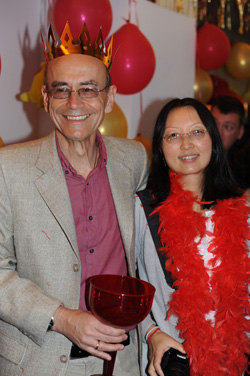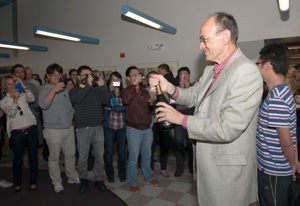October 21, 2013 - By Ruthann Richter

Südhof talks with Marius Wernig and Marcia Cohen Oct. 10 at a campus party held to celebrate the news of his Nobel Prize.
Thomas Südhof, MD, arrived at his lab on Oct. 10 — his first day back on campus since the news of his Nobel Prize in Physiology or Medicine — to a surprise welcome of cheers, applause and a room festooned with fuchsia streamers, red and yellow balloons, and a plastic red carpet.
A professor of molecular and cellular physiology, Südhof surveyed the crowd of some 60 young scientists, including many of his postdoctoral scholars and graduate students, and was momentarily speechless.
Finally, he said, grinning, "Can I go to work now?"
Not one for the limelight, the 57-year-old neuroscientist is far happier at a lab bench than in front of a TV camera. "After all these years, sometimes people ask me if I still like doing science — whether I'll retire now," Südhof said. "I am just as excited about the actual data as I was 30 years ago. I think the ultimate reward for me is to find something interesting. So while obviously I am overwhelmed by this prize and incredibly happy, I'm just as happy about some new interesting data."
After a sleepless, overnight flight to Madrid, Südhof was en route to a conference in central Spain when he received the call from Stockholm. He'd been driving four hours in search of the conference site in the remote, cliffside town of Baeza; he pulled over, thinking it was his colleague wondering where he was. Instead it was the Swedish-accented Adam Smith, editor of the Nobel Prize website, who recorded Südhof's first sputtering words of astonishment.
'Cranky and tired'
Südhof described his mood as "cranky and tired" at the time of the call. "But my mood changed dramatically," he said, adding that he was incredulous at the news.
For those who know and work with him, it was hardly a surprise. "I was always expecting he would get it," said Axel Brunger, PhD, professor and chair of molecular and cellular physiology, who has collaborated with Südhof on research projects. "It really was a question of when, not if."
Südhof, the Avram Goldstein Professor in the School of Medicine, was honored for helping to explain the lightning-quick process by which neurons in the brain communicate with each other across gaps called synapses. Synapses help transmit the messages that underlie all human thought, emotion and activity. Südhof's work with these critical structures could have a bearing on neurologic disorders, such as Parkinson's disease and Alzheimer's disease, as well as on neuropsychiatric conditions, such as autism and schizophrenia.
It's not the first big honor for Südhof, who is a Howard Hughes Medical Institute investigator: He won a prestigious Lasker prize in September, and in 2010 he was named a recipient of the Kavli prize, which included a visit to the White House. He shares this year's Nobel with two other Americans: Randy Schekman, PhD, of UC-Berkeley, and James Rothman, PhD, of Yale University. Their work complements his own, he said.
Tall and lanky, Südhof is given to wearing V-neck sweaters in pink, purple or yellow, regardless of the weather, and Birkenstocks with socks. For his White House visit three years ago, he stood in his Birkenstocks next to President Obama and was the only celebrant not wearing a tie; the idea simply hadn't occurred to him.
Südhof was born in the 18th-century university town of Göttingen, Germany. His parents, both physicians, were followers of the alternative philosophical movement of Rudolph Steiner, and Südhof received his primary education at Waldorf schools, whose pedagogical approach is based on Steiner's educational philosophy. He attended the University of Göttingen, where he completed undergraduate and graduate studies in medicine.

Südhof talks with Brian Kobilka, the 2012 Nobel laurate in chemistry, on Oct. 10.
As a youngster, one of his formative experiences was his study of the bassoon. "My music teacher had a huge influence on me," he said in an interview in his spare first-floor, corner office at the Lorry I. Lokey Stem Cell Research Building. "Classical music trains you to be creative and requires enormous discipline. It's very hard work."
After finishing his medical internship in Germany, Südhof obtained a postdoctoral appointment in 1983 at the University of Texas Southwestern Medical Center in Dallas, under Joseph Goldstein, MD, and Michael Brown, MD. His two mentors went on to win the Nobel Prize in Physiology or Medicine in 1985 for their work in understanding the regulation of cholesterol metabolism.
Though Südhof also started out in the field of lipid metabolism, succeeding in cloning the gene for the LDL receptor, he shifted his focus to the workings of the synapse. At Goldstein's encouragement, he decided to forgo the practice of medicine and instead devote himself to basic research, which he said is now being increasingly neglected in the United States in the rush to develop new therapeutics.
Laying foundations
"I strongly feel that attempts to bypass a basic understanding of disease and just to get to therapies immediately are a misguided and extremely expensive mistake," said Südhof, who speaks English with a German accent. "The fact is that for many of the diseases we are working on, we just don't have an understanding at all of the pathogenesis. There really is not much to translate. So NIH and many of disease foundations are pouring money into clinical trials based on the most feeble hypotheses."
His goal, he said, is to improve on that fundamental understanding of disease, and he's already made some inroads there. The work for which he is best known involves a part of the synapse known as the presynaptic terminal, which resembles a small knob, thousands of which protrude from a single neuron. Each terminal houses hundreds of tiny bubbles known as synaptic vesicles, which hold neurotransmitters — chemicals that transmit messages between nerve cells. When an electrical impulse traveling down the neuron's surface reaches the presynaptic terminal, the vesicles fuse with the terminal's outer membrane. This prompts the vesicles to release the neurotransmitters so they can pass their messages along.

Südhof's laboratory team held a surprise party for him when he returned to work Oct. 10 accompanied by his wife, Lu Chen.
It is a very precise process that takes place in less than a millisecond. Using the tools of electrophysiology, among other techniques, Südhof discovered the specific proteins that make membrane fusion, and synaptic communication, possible.
"Tom discovered the factors that make the process regulated and so fast," Brunger said. The speed and precision of the process in this setting is unique, Brunger explained, far faster and more precise than the membrane fusion that occurs when a virus infects a host or when insulin is released into the bloodstream.
Südhof is less known for his research on how synapses are formed, maintained and structured. It's an important area as well, he said, as synapse dysfunction can lead to diverse neurologic problems, including autism and schizophrenia. "It's strange that these extremely disparate disorders might all relate to synapses because they are so different, but they are related to synapses in very different ways," Südhof said.
These are some of the daunting questions he is trying to answer. He keeps at them bit by bit, day by day. "He's very intense and has an amazing capacity to work," said Jose Rizo-Rey, PhD, professor of biophysics at UT-Southwestern and a collaborator for 20 years. "Biology is complicated because so many things can happen inside the cell. There is a lot of interpretation. You can use logic, but there are many times you just have to have intuition about what is right and what is wrong. He has very good intuition and knows the right questions. And he has a prodigious memory."
Taking risks
His lab members say he is willing to take intellectual risks, for that is how science moves forward."He is always open, even to some crazy idea," said Lulu Chen, PhD, a postdoctoral scholar in his lab. "'I will never say no to you,' he says, 'because it never hurts to try.'
"He is a great mentor," she added. "Besides science, he is a generous person — whether it's with resources or sharing his time. He is such a busy person, but he always makes himself available. He makes you feel so comfortable. That one so prestigious can be so down to earth — that is something special."
His wife, neuroscientist Lu Chen, PhD, (no relation to Lulu Chen), said she was immediately drawn to him because of his direct approach, his energy and drive.
"He is so authentic," said Chen, an associate professor of neurosurgery and of psychiatry and behavioral sciences at Stanford. "Very often you encounter people who are super-friendly, but afterward you don't feel you know the person at all. But he is different. He is very direct and straightforward. It fits me very well because I'm the same way. We were able to talk at a deep level — about science, politics and philosophy. A chord was struck. It was a wonderful feeling."

All eyes — and iPhones — are on Südhof as he prepares to pop the cork.
The couple live in Menlo Park, Calif., with their two children, ages 3 and 4. Südhof also has four children, now in their 20s, from a previous marriage.
By the time Südhof moved to Stanford, he had spent 25 years at Southwestern, including 10 years as a department chair. He decided he needed a change — that he may have accomplished all that he could there, he said. And he'd become worried about the increasingly conservative political environment in Texas in which schools balked at teaching fundamental scientific concepts like evolution.
With a strong nudge from his longtime collaborators at Stanford, he joined the faculty in 2008, bringing many of his lab members with him.
While Südhof is a great lover of music and art, as well as of hiking and travel, these days he has little time for any of these pursuits; work and family occupy his time. "My children govern my life totally," he said, cheerfully.
Chocolate reward?
And how did the little ones react to the Nobel Prize? "Does it mean we get chocolate?" they wanted to know. No, but they will get a big party in a place far away, and for that they are very excited, Chen, his wife, said.
Südhof said he likely will use his share of the roughly $1.2 million prize to finance his children's education.
He said his return to the Bay Area has been mostly a whirlwind of parties, but he hoped that life would soon return to normal, and that his lab would continue to function as usual. But if experience is any guide, that's not likely to be the case, said colleague Brian Kobilka, MD, professor of molecular and cellular physiology and a 2012 winner of the Nobel Prize in Chemistry.
Speaking to several hundred people at a party for Südhof in the Beckman Center, Kobilka said he had been besieged by emails, requests and autograph seekers, including one graduate student who sent him a lumpy Fed-Ex package with two baseballs to be autographed. He dutifully signed them and sent them back. Südhof said later that he, too, received two baseballs awaiting his autograph.
"It's going to be an amazing, crazy experience," Kobilka said. "You deserve it. It might throw you off balance for a while, but I'm confident it won't be for long."
That is a good thing, said Südhof, for there is much to be done.
About Stanford Medicine
Stanford Medicine is an integrated academic health system comprising the Stanford School of Medicine and adult and pediatric health care delivery systems. Together, they harness the full potential of biomedicine through collaborative research, education and clinical care for patients. For more information, please visit med.stanford.edu.